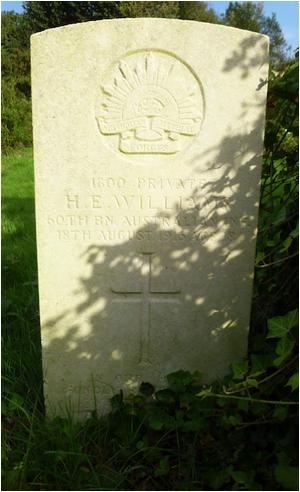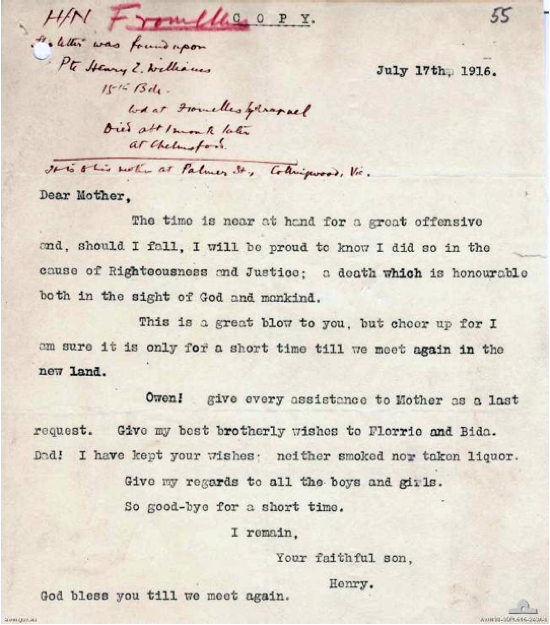Henry Egryn Williams was an Australian who joined the army in his home country in January 1916. He landed in France in June 1916 and was severely wounded there the following month. He was brought to England for hospital treatment and died at the Red Cross Hospital in Chelmsford in August 1917. In 2014 an Australian newspaper reported that a message in a bottle he and comrades had thrown overboard when he left for Europe had stayed in the possession of the finder’s family ever since.
WILLIAMS, HENRY EGRYN*,
Private, 60th Battalion, Australian Infantry
soldiers from the Red Cross Hospital, several of them having their arms in slings. Other wounded soldiers, among whom were some Colonials. followed carrying wreaths. The pipers led the procession, playing a lament, and were followed by the brass band who subsequently played the ‘Dead March.
Behind followed Miss Kemble, the Commandant at the Red Cross, and nurses in motor cars, and a detachment of the men’s Voluntary Aid Detachment (V.A.D.), under Section-Leaders E. J. Runter, F. Cowley, and W. Clark, brought up the rear on foot. It was a pathetic procession, and was witnessed by a good many people.
The Senior Church of England Chaplain of the Division, the Rev. L. D. W. Spencer, officiated, and at the graveside a verse of ‘Lead, Kindly Light’ was sung, accompanied by the band.. Following the blessing the customary three volleys were fired and the ‘Last Post’ sounded.
The floral tributes were: - ‘To a brave hero’, from the Sisters, day nurses, Commandant, John and Golding, Red Cross Hospital: the night nurses at the Hospital; officers and men of the Chelmsford V.A.D., with a suitable verse by Rupert Brookes; ‘An Australian mother mourns a dear son, in affectionate remembrance’, ‘In sorrow for the mother so far away’: Wounded inmates, ‘with kind remembrances of a true comrade’; ‘To a lonely hero who gave his life for his mother country’, from a sympathising mother, ‘Peace, perfect peace’; ‘Greater love hath no man than this, that a man lay down his life for his friends’; and Mrs. E Stanton Jerdein, of St. John’s Wood.”
On 8th May 1919 Henry’s body was exhumed and reburied in single grave 2116 where it rests today..
Henry is commemorated on the Australian War Memorial in Canberra. He was entailed to the British War Medal and the Victory Medal.
Henry's father died on 22nd February 1919. His cousin Private 248 Llewellyn Williams of the 21st Battalion, A.I.F. was killed in action two days before Henry's death.
Henry’s story has an interesting postscript almost a century after his death. On 4th January 2014 the West Australian Newspaper reported:
“Gathered aboard a troop transport ship at Albany in 1916, the four young Aussie blokes were full of enthusiasm and hope, and no doubt champing at the bit to get off the ship and on with their grand adventure.
They must have had little idea about the horrors that awaited them on the bloody battlefields of World War I's Western Front. Perhaps just to pass the time, they penned a letter, stuffed it in a jar and tossed it overboard in the hope someone, anyone, would find it. A little over four months later one would be dead. Just over a year later a second would fall.
Now, almost a century later, their letter has come to light, providing a remarkable insight into the minds of the soldiers and the history of the time. It sits in a glass jar in the Attadale home of Sharon Kent, whose family has had it since her grandfather, Charles Blythe, found it, as best as anyone knows, on an Albany beach in the 1930s.
Scratched into the lid is a notation that appears to read 19/4/16. The two pages of the letter itself are yellowing and marked with deep creases and written in an elegant hand on letterhead which reads: "Melbourne YMCA on active service with the Australian Imperial Forces."
It is dated Tuesday April 11, Albany 1916.
"Dear friend," the letter begins. "Would you the finder of this message be so kind as to write and let our people know that you found (it) . . . and say that we are having a grand time and in the best of health and on our way to Egypt.
"By doing so friend we should be very grateful and only too pleased to hear from you saying you have found it also we may have the pleasure of thanking you again."
On page two each gave an initial or initials and their surname, war service number, battalion, listed their address as "Australian Intermediate Base Egypt" and then added addresses of families in Victoria.
Mrs Kent said her family was not aware of any contact having been made with the families and she had made a start on trying to track them down some time ago, but had been unsuccessful.
However, with the centenary of the war approaching, she wanted to try again.
The Weekend West, with help from the Australian War Memorial and the National Archives, set out to shed light on the men.
The first of the four letter writers gave his name as H. Coxon. Harold Coxon, number 5363, whose family lived in Abbotsford, Melbourne, was originally a reinforcement for the 8th Infantry Battalion and with his three mates had embarked on April 4, 1916 from Melbourne aboard HMAT Euripides A14. His enlistment paper says he was a salesman and not married when he joined up on January 17, 1916 aged 20. The AWM said he joined the 5th Battalion in October 1916 and was promoted to corporal on March 6, 1917. He spent time in hospital in May 1918 and in July 1918 he received a gunshot wound to his right hand and was evacuated to England for treatment. He returned to Australia in January 1919.
Fate was not so kind to R. Swift, number 5458. Reginald Norton Swift, from Northcote, was also a reinforcement for the 8th Battalion, and a farmer when he enlisted on January 22, 1916 aged 24. He, too, was unmarried and in 1917 he found himself in a fierce battle at Lagnicourt, northern France. According to the AWM, "the Germans launched a counter-stroke in the Lagnicourt area at dawn on 15 April, utilising 23 battalions". Records say Swift died of wounds on April 19 and was buried at Grevillers British Cemetery, in France. Details provided to the government after his death say he was "of a genial and kindly temperament steady and reliable and well liked by all with whom he came in contact".
Soldier three was J.V. Brown, number 5489. James Valentine Brown, of Ballarat, was an advertising agent when he joined up on November 11, 1915 aged 26. Not married, he was also a part of the 8th Battalion and was also a member of its band. He spent some time ill in hospital in July 1918 and came home in March 1919.
H.E. Williams, number 1800, provided a tragic end to the search. Henry Egryn Williams, whose family lived in Collingwood, was an engraver with the Government Printing Office and not married when he enlisted in January 1916 aged just 19. First with the 57th Battalion, he joined the 60th Battalion in May 1916. The AWM said that on July 19, 1916 he received a gunshot wound to his left thigh and was evacuated to England for medical treatment. The memorial's history of the 60th Battalion says it "became embroiled in its first major battle on the Western Front on 19 July, without the benefit of an introduction to the trenches in a 'quiet' sector. The battle of Fromelles was a disaster for the battalion. In a single day it was virtually wiped out". Williams was admitted to Chelmsford Red Cross Hospital on July 22. He died on August 18, 1916. He was, as the soldiers' letter finished, one of four mates who set off into the unknown and who would "try to do their best".
140316

Henry was born in Collingwood in Victoria, Australia in 1896, the son of William Williams and May Ann Victoria Williams.
Henry joined the army on 17th January 1916. He was employed as a process engraver. He attested on 1st April 1916, and swore his oath the following day at Broadmeadows in Victoria. At the time he was aged 19 and resident at Collingwood, Victoria. His father lived at 73 Palmer Street, Collingwood. He was 19 years and six months old, five feet ten inches tall, weighed 149 pounds. He had a fresh complexion, fair/brown hair, blue/grey eyes, and was a Methodist. He was unmarried.
During the First World War Henry served as Private (acting Corporal) 1800 in B Company, 60th Battalion, Australian Infantry, A.I.F., having previously served in 2/57th Battalion.
Henry embarked from Melbourne, Australia on 4th April 1916 on H.M.A.T. Euripedes. On 25th May 1916 he disembarked from the vessel at Alexandria, Egypt. On 18th June 1916 he travelled to France on board H.M.T. Kinfauns Castle and disembarked from her at Marseilles on 29th June 1916.
On 17th July 1916 Henry wrote a letter to be sent to his mother in the event of his death (see below).
On 19th July 1916 he was wounded in action, suffering a severe shrapnel wound in his left thigh and buttock. He was admitted to the 14th General Hospital in Wimereux and
two days later, on 21st July 1916, he left Boulogne, France and was transported to England on the Hospital Ship 'Jan Brydel'. He went to the General Military Hospital at Colchester the following day and was one of a detachment of soldiers admitted that day to the General and Red Cross Hospital in New London Road, Chelmsford. His condition from the outset was very grave.
On the morning of 18th August 1916 Henry died from a secondary haemorrhage of his wound at the Red Cross Hospital in New London Road, Chelmsford. A report of his death stated: "He was conscious almost until the last and not in great pain. He left no messages. The Sister in charge who was constantly with him was a woman of an exceptional type and far above the average. A perfectly splendid woman, so he had every care and attention. A military funeral is being arranged for Monday 21st August 1916 at the Chelmsford Cemetery. His things have been sent to his mother."
Henry was buried with full military honours at Chelmsford Borough Cemetery in Writtle Road (initially in common grave 194). A contemporary newspaper report stated:
““The 2/7th Royal Scots’ provided the escort, firing party, and the pope and brass bands. The coffin, covered with the Union Jack and lovely floral emblems, was carried to the field gun by wounded
